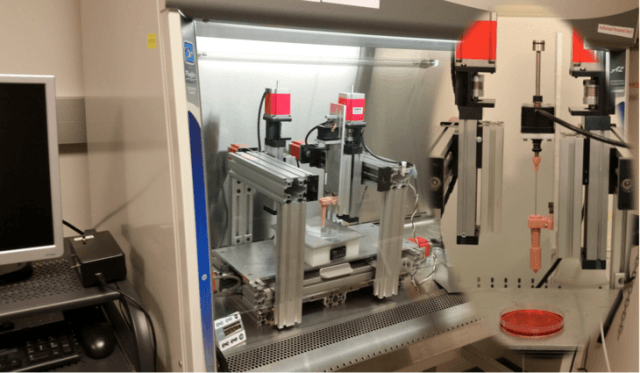Jun 29 2016
According to engineers, strands of cow cartilage can act as an alternative to ink in a 3D bioprinting process that might lead to the creation of cartilage patches for damaged joints.
 A multiarm bioprinter. (Image: Ozbolat Lab / Penn State)
A multiarm bioprinter. (Image: Ozbolat Lab / Penn State)
"Our goal is to create tissue that can be used to replace large amounts of worn out tissue or design patches," stated Ibrahim T. Ozbolat, Associate Professor of engineering science and mechanics. "Those who have osteoarthritis in their joints suffer a lot. We need a new alternative treatment for this."
Cartilage contains only a single cell type and does not have blood vessels within the tissue, making it ideal to target for scale-up bioprinting. It cannot repair by itself, once it has been damaged it remains so.
Earlier attempts to grow cartilage started with cells implanted in a hydrogel, which is a material containing polymer chains and around 90% water and is used as a scaffold for growing the tissue.
Hydrogels don't allow cells to grow as normal. The hydrogel confines the cells and doesn't allow them to communicate as they do in native tissues.
Ibrahim T. Ozbolat, Associate Professor, Penn State University
This results in tissues that do not possess adequate mechanical integrity. The hydrogel can also produce toxic compounds upon degradation that are harmful to cell growth.
Ozbolat and his colleagues formulated a technique to produce larger scale tissues without the use of scaffolds. The researchers created a small (from 3-5 one hundredths of an inch in diameter) tube composed of alginate which is an algal extract. The researchers inserted cartilage cells into the tube and allowed them to grow for a week and stick to one another. As the cells do not adhere to alginate, it is possible to remove the tube and remain with a cartilage strand. The scientists published their findings in the recent issue of Scientific Reports.
The cartilage strand can act as an alternative to ink in the 3D printing process. The 3D printer lays down lines of cartilage strands in any pattern the scientists select using a specifically designed prototype nozzle that could grasp and feed the strand of cartilage. The cartilage patch sticks to itself sufficient to move to a petri dish after about 30 minutes. The scientists place the patch in nutrient media in order to further incorporate into a piece of tissue. Ultimately the strands completely attach to each other and combine together.
We can manufacture the strands in any length we want, because there is no scaffolding, the process of printing the cartilage is scalable, so the patches can be made bigger as well. We can mimic real articular cartilage by printing strands vertically and then horizontally to mimic the natural architecture.
Ibrahim T. Ozbolat, Associate Professor, Penn State University
Native cow cartilage and the artificial cartilage formed by the team are alike. Though the mechanical properties are not as good as those of natural cartilage, it is superior over the cartilage prepared using hydrogel scaffolding. Pressure from the joints forms the natural cartilage and Ozbolat thinks that mechanical pressure on the non-natural cartilage will develop its mechanical properties.
If this method is ultimately applied to human cartilage, then to stop elimination by the tissue every individual would have to provide their source material to prevent tissue rejection. The source can be either cartilage or stem cells which are differentiated into cartilage cells.
Yin Yu, Ph.D. from the University of Iowa currently at Harvard University; Kazim K Moncal, graduate student in engineering science and mechanics and member of the Huck Institute, Penn State; Weijie Peng, visiting scholar in engineering science and mechanics, Penn State; Iris Rivero, Associate Professor of industrial manufacturing and systems engineering and Jianqiang Li, former student, Iowa State University; and James A. Martin, Associate Professor of orthopaedics and rehabilitation, the University of Iowa were also part of this project.
This research was funded by the China Scholarship Fund, Grow Iowa Value Funds and the National Science Foundation.